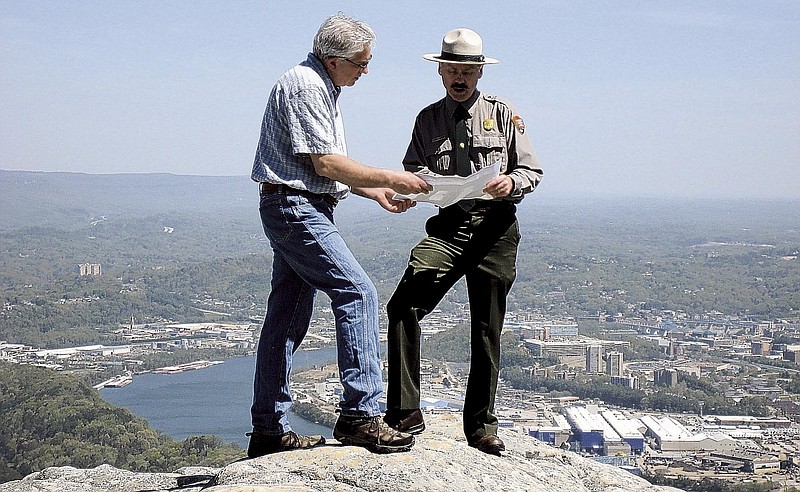A painting of the Battle of Lookout Mountain from the Union Army perspective, done by a Confederate soldier who wasn't even there, is bound to have a few mysteries surrounding its creation.
Wes Cowan, host of Public Broadcasting System's "History Detectives," sought to unravel the tale with a visit to Chattanooga earlier this year, following inquiries from the painting's Portland, Ore., owner.
"It's a great story," he said. "We had a lot of fun doing it."
The details of Mr. Cowan's sleuthing will be revealed when the show airs this month on WTCI-Channel 45, according to the station's Pam Carpenter, but several things are clear.
The painting, a watercolor on paper, was done by Pvt. John F. Gisch, a member of the 24th Alabama Infantry Regiment. He was captured at the Battle of Missionary Ridge on Nov. 25, 1863, and eventually sent to the newly opened Rock Island Prison in Rock Island, Ill.
He was on Missionary Ridge the day before his capture, Nov. 24, during the Battle of Lookout Mountain.
The painting apparently was completed while Mr. Gisch, a native of Germany, was in the Illinois prison. It was given to a fellow Confederate prisoner who was captured at the Battle of Lookout Mountain. That man, Thomas A. Cocke of the 29th Mississippi Infantry Regiment, later passed the work to Mary Robertson, the great-great grandmother of present owner Bill Dodge.
Mr. Cowan said the prisoner of war camp may have allowed its inhabitants to purchase items such as art supplies from civilian peddlers or the supplies may have been sent by family members.
Jim Ogden, historian for the Chickamauga and Chattanooga National Military Park, said he was not familiar with Mr. Gisch's work but was acquainted with watercolors by Civil War prisoners.
IF YOU WATCHThe "History Detectives" episode will air at 9 p.m. July 26 on public television station WTCI-Channel 45.
"The fact that prisoners in camp were able to do something like that in the prison camp is not a surprise," he said.
Mr. Ogden said the skirmish depicted was important in the overall battles for the city.
"Chattanooga is the great doorway, gateway, passageway to the Deep South," he says on the upcoming broadcast. "Without Chattanooga, the drive of the Union Army in 1864 under (Gen. William T.) Sherman would not have been possible."
The scene represented in the 181/2-by-14 painting is from behind the blue-clad Union line near the Cravens House on a small outcrop of level land halfway up Lookout Mountain. The gray-clad Confederate soldiers are withdrawing back up the mountain.
"It's a useful illustration to help relate and give a sense of the Battle of Lookout Mountain and its final phases," Mr. Ogden said.
The Cravens House area, according to the park historian, became a focal point of the battle because it was open ground and because the house -- often referred to by soldiers as "the white house" -- was one of the mountain's principal landmarks at the time.
"The views into and across the 100 acres of open ground attracted many soldiers and many units," he said. "They gravitated to that."
Mr. Cowan said Mr. Gisch was not a professional painter and apparently did not paint after he was released from prison. He said he couldn't estimate the watercolor's worth.
"He was not a professional artist," he said. "You would call him a folk or naive artist."
However, "The Battle of Lookout Mountain" is a "very detailed folk art painting," Mr. Cowan said. "It's in terrific condition. The colors are vibrant. It really captures the scene."
Ronnie Janecka, of Houston, Mr. Gisch's great-granddaughter, said she knew relatively little about her ancestor, who died before 1900, until representatives of the show contacted her.
She knew he served 19 months in the prison, married in New Orleans and later lived and was buried in Pascagoula, Miss. From online research, she also knew of a watercolor he did of activity at the Rock Island Prison.
Ms. Janecka, 66, discussed her research with a friend several years ago. The friend realized the Rock Island Prison was on Arsenal Island, where her mother-in-law worked in a gift shop and where Mr. Gisch's painting is housed.
Eventually, Ms. Janecka visited the museum, where the painting is kept in a vault, and was told about two other watercolors her great-grandfather had done.
However, she did not know about the Battle of Lookout Mountain watercolor, and a fifth work has surfaced from an Illinois collector since the show was taped in April.
Ms. Janecka said she appreciated the detective work Mr. Cowan did.
"I learned how much passion and warmth I have for this man in knowing who he is," she said.
